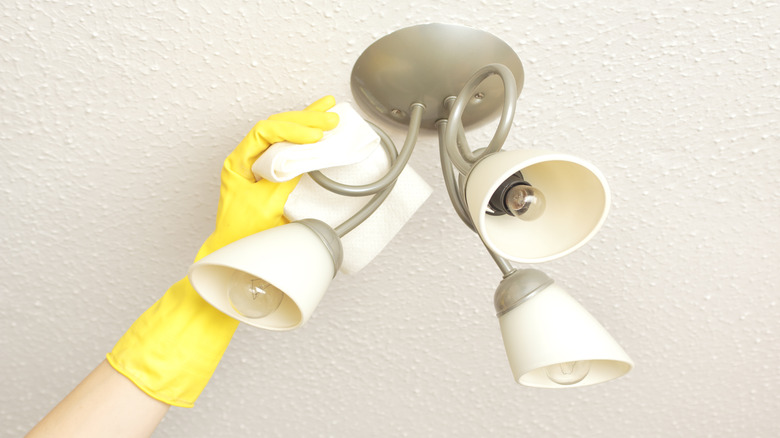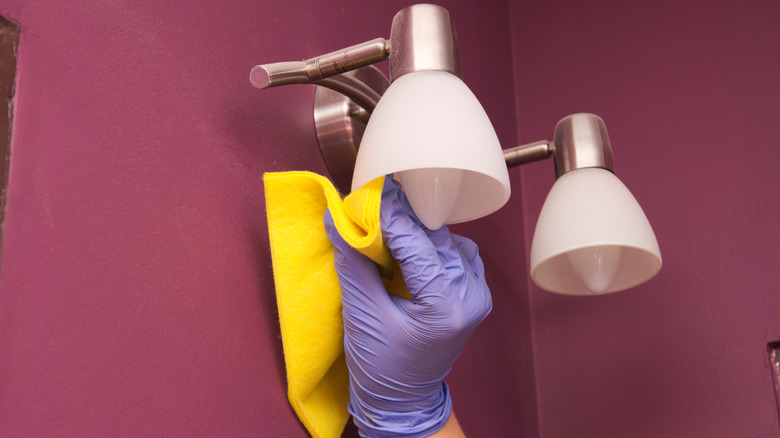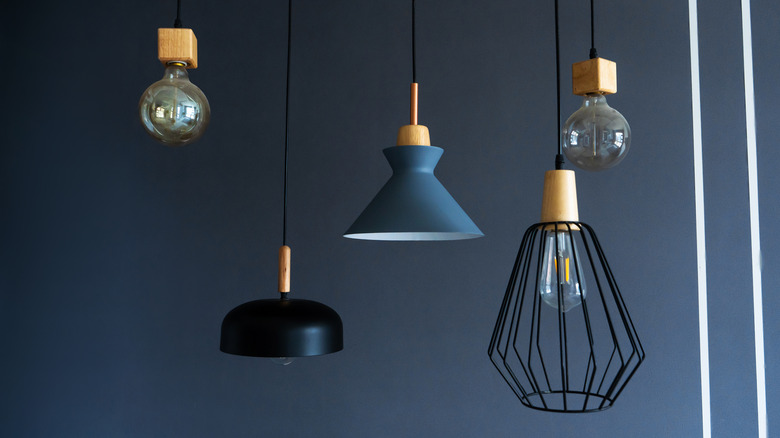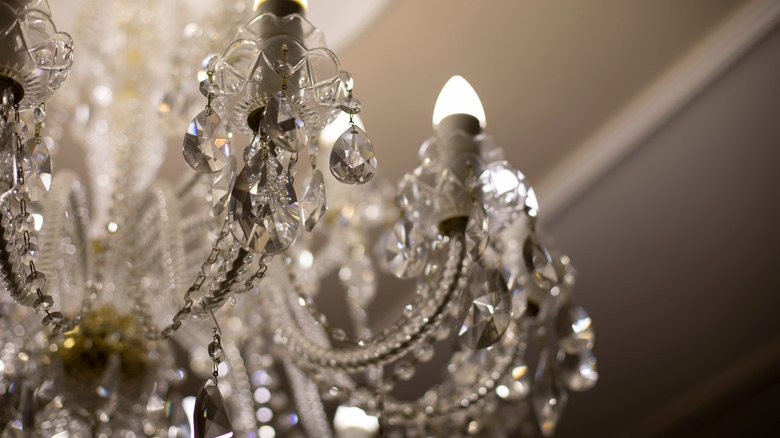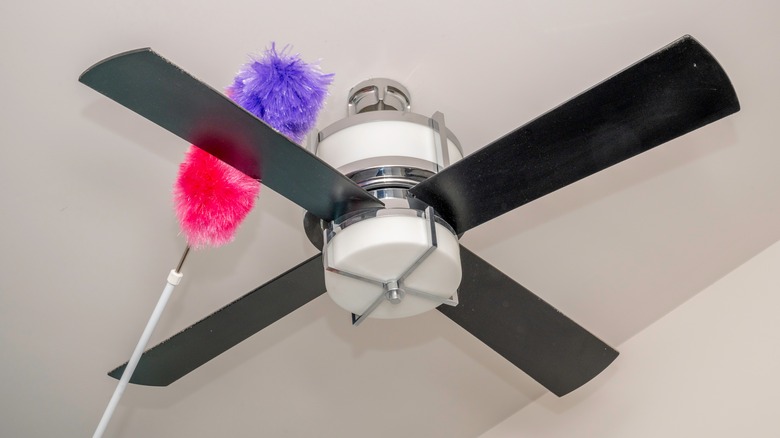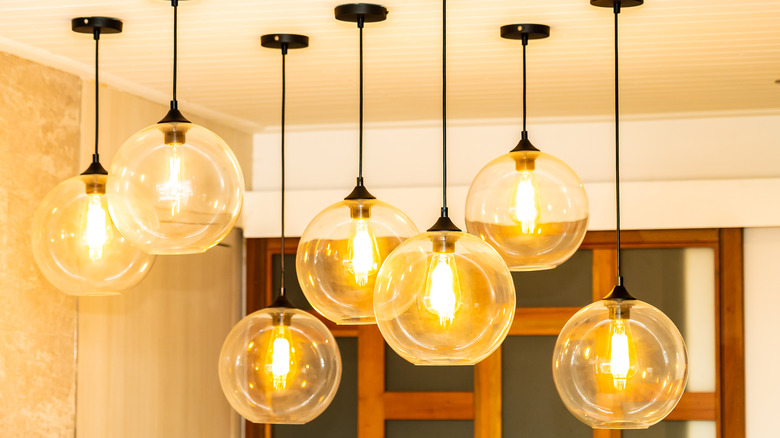The Best Way To Clean Light Fixtures
While cleaning your home is vital for maintaining a tidied space and eliminating germs, the responsibility of scrubbing every corner can be overwhelming. One of the harder to clean areas of your home, and often the most neglected, is your ceiling, specifically the hanging light fixtures. As the Maid Sailors note, dust will accumulate if you don't regularly clean your light fixtures, diminishing the glow that comes through. If situated in an enclosure, your hanging lights' intensity can also be dampened if dirt, dust, and bugs become trapped inside.
Dirty light fixtures can also inadvertently increase your energy consumption, warns Sandi Pressley, who says dirty bulbs are 30% less bright than clean ones. Dust is also a dangerous material to have near electricity, especially that which can spark — such as a faulty light bulb, via StreetDirectory. Luckily, you can avoid all the issues mentioned above by learning to clean your light fixtures.
Wipe down the light bulbs
The Maid Sailors recommend a deep clean of your light fixtures anywhere from one to two times a year, but that largely depends on how much air circulates in your home, the number of pets you have, what kind of light fixture has been installed, and how quickly the dust starts to impact your air quality. Before you clean your light fixtures, you should prepare by turning off and, if applicable, unplugging all your lights.
Light bulbs and fixtures are powered by electricity, and mishandling it can result in a shock if you're not careful. You can also burn your hands on hot light bulbs if you don't let them cool down before cleaning. During a deep clean of your light fixtures, you should start with your light bulbs, which are not immune to dust collection. Wait for them to cool off and unscrew them. Then, using a dry microfiber cloth, simply wipe them down until there isn't any dust left.
Be gentle on metal light fixtures
Each light fixture requires a unique approach and cleaning method to keep it looking as best as possible. For example, those with metal finishes should be treated differently than glass or plastic, as the metal could tarnish. Most metal light fixtures will be found as hanging pendants, so make sure you have a ladder to reach them.
Once your bulb has cooled off, remove and set it aside. Progress Lighting warns that you should only use mild and non-abrasive cleaning products and materials. Rough cloths or cleaning products with ammonia or alcohol can scratch, wear down, and tarnish the metal coating, as can most glass cleaners and all-purpose cleaners. Instead, use a simple mixture of mild dish soap, warm water, and a soft microfiber towel to clean and dry it off. If you want to add shine and extra protection, you can also use a gentle wax or paste, like Turtle Wax or other metal-specific shining products.
Disassemble chandeliers
More complicated light fixtures will require a bit more work. Chandeliers, for example, have lots of places for dust to settle and hide. While regularly cleaning with a duster will help with dirt and dust build-up, it won't completely eliminate it. This is why FliptheSwitch recommends disassembling your chandelier for a deep clean a few times a year.
Begin by taking down your chandelier and removing the light bulb. After taking stock of the chandelier, prepare a sink or bowl full of warm water with mild dish soap, so you know where each piece will go when reassembling. Add water-safe pieces like the pendant, saucer, and any crystals in the soap-water mixture. If you have genuine crystals, check to ensure they're water safe. Use a microfiber or flannel towel to dry off each part, and set it aside. As for the main structure, use a damp cloth to wipe it down and another to dry it off. Put the completely dry chandelier back together, add the light bulb, and hang it up again.
Baby wipes for ceiling fan blades
Many homes, especially those in warmer regions, have ceiling fans attached to their lighting fixtures. Learning how to clean the ceiling fan is just as important as the light itself, especially since the dust can get trapped on the top more effortlessly than it can settle inside a light saucer. Weekly cleaning with an extendable duster is ideal, but you should also deep clean the fan blades once or twice a year, per DelMar Fans and Lighting.
Before cleaning your ceiling fans, get a construction mask or bandana to prevent dust and dirt from getting in your mouth or nose. Shield your eyes during the initial dusting, too. Begin by removing as much surface dust as possible, then set up a ladder to reach the fan. You can use baby wipes to clean off the blades from built-up dirt, as well as simply soapy water. Clean both the top and bottom of the blades. Then, clean off the light itself. If the blades are greasy, you can use a degreaser on a damp cloth to remove the buildup.
Microfiber towels for glass shades
One of the trickier lighting fixtures to clean is glass pendants. While cleaning the glass seems simple enough, the globe shape makes the process somewhat tricky, with streaks often left behind on the unforgiving material. Melissa Tyler of Lake and Lumber told Progress Lighting that she uses a glass-specific microfiber cloth to avoid this particular problem.
Once a month, simply use a microfiber cloth made specifically for polishing glass and give your glass fixture a vigorous cleaning. You don't even need to use glass cleaning spray for this, as it will just leave behind streaks. If you do this regularly, you shouldn't have too much dirt or grease buildup. If there is sufficient buildup, you can use soap and water to remove it, and then use your microfiber cloth to polish out any streaks. Don't forget to clean the inside of the shade, as well as the supporting hardware.
